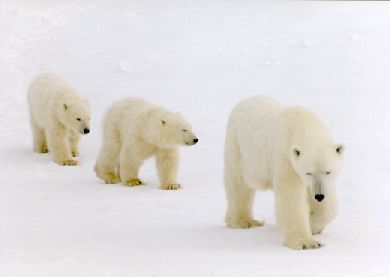
Moving along
Walking Polar bears have long legs, so even when it seems they are moving slowly, they are taking such big steps that it doesn't take them long to get somewhere. Polar bears are a little "pigeon-toed" which means that their toes point inward instead of straight ahead. A comfortable walking pace would be 5km/hr (3mph) which we could probably keep up with if we were walking on a smooth sidewalk, but polar bears can walk that fast on uneven tundra. They also can walk for many hours. One polar bear was tracked walking 80km(50miles) in one day. |
| Running Not even the world's fastest runner could outrun a polar bear. For short distances, they can run 50km/h (30mph)! They can only do it for a short distance because all that fur and fat on them will make them overheat. |
| Swimming "Sea bear" is the Latin name for a polar bear because they are so at home in the water. They use their front paws to "doggy paddle" and their back paws to steer them in the direction they want to go. There is so much air trapped in their fur that it helps them float. Their fur and their fat may keep them from running far, but it does keep them warm when they want to swim in the chilly Arctic Ocean. Polar bears have been spotted swimming by sailors over 100km (60miles) from shore. If a polar bear is on the ice hunting when spring comes, the ice will melt and the bear is forced to swim to shore. With their thick layer of fat for warmth and energy, and their fur to help them float, they can swim for days if they have to. |
All photos and images are for use at the author's discretion.
Please gain permission before using.
Copyright © 2000-2004 mikepolarbear@yahoo.ca
Please gain permission before using.
Copyright © 2000-2004 mikepolarbear@yahoo.ca

